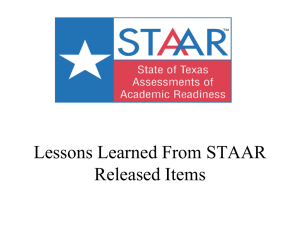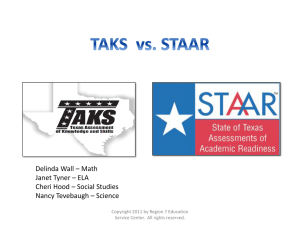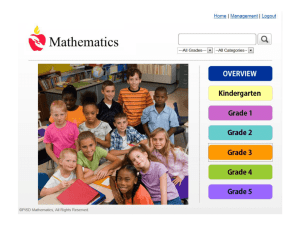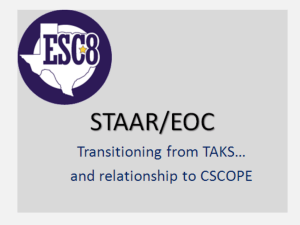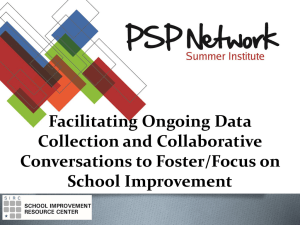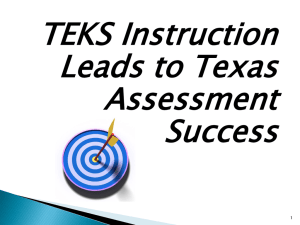Utilizing Data to Facilitate Academic Growth in Middle School
advertisement
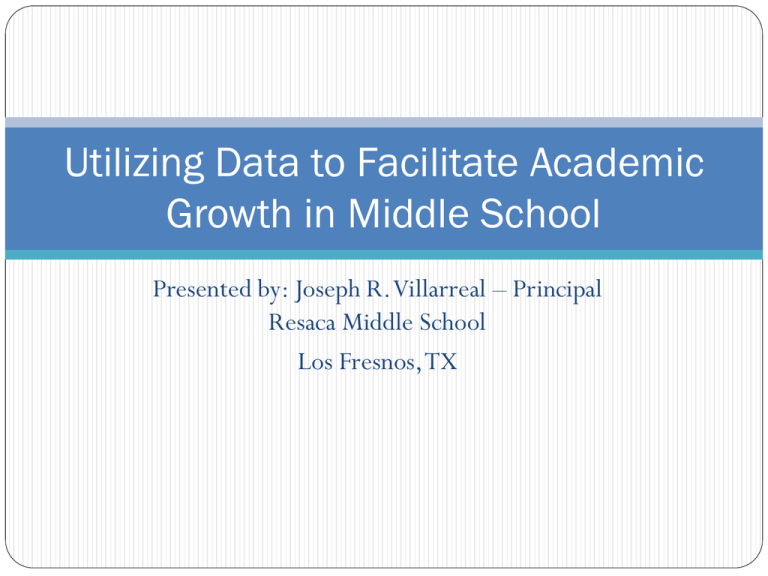
Utilizing Data to Facilitate Academic Growth in Middle School Presented by: Joseph R. Villarreal – Principal Resaca Middle School Los Fresnos, TX RESACA MIDDLE SCHOOL DEMOGRAPHICS Located in Los Fresnos in the Rio Grande Valley Population – 872 students (6-8) African American - .3% Hispanic – 95% White – 5% Economically Disadvantaged – 78% Advanced Academics – at least 50% of all students are enrolled in at least one Pre-AP class Accelerated Reader is a curriculum requirement STATE ASSESSMENT DATA YEAR MATH READING SCIENCE SS WRITING 2011 89 92 90 99 97 2010 90 93 95 99 99 2009 91 94 85 98 100 DATA IS EVERYWHERE School data is everywhere. Lexiles Quantiles Vertical Scale Scores Raw Score Schools have enough data to clearly define their strengths and weaknesses. THE CHALLENGE IS NO LONGER GETTING DATA. DATA IS EVERYWHERE The challenge now is using data to improve school and classroom practices and to raise students’ achievement while they are in school. It is easy to obtain end-of-the-year data, such as state assessments results; however, schools need to take a proactive approach in obtaining data throughout the school year. This includes data obtained from formative assessments and classroom practices. This data will allow schools to diagnose early and provide immediate remediation. Comparison of Traditional and Data-Driven Decision Making Decision Making Based on Intuition, Tradition, or Convenience Data-Driven Decision Making Scattered staff development programs Focused staff development programs as an improvement strategy to address documented problems/needs Budgetary decisions based on prior practice, priority programs Budget allocations based on data informed needs Staff assignments based on interest and availability Staff assignments based on skills needed as indicated by data Staff meetings that focus on operations and the dissemination of information Staff meetings that focus on strategies and issues raised by school data Grading system based on each teacher’s criteria of completed work and participation Grading systems based on common studentperformance criteria that report progress on the standards as well as work skills Periodic administrative team meetings focused solely on operations Administrative team meetings that focus on measured progress toward data-based improvement goals DATA IS EVERYWHERE Collecting the data should be a planned, purposeful process. Valuable data will guide the school in developing improvement goals for the benefit of all students. State Assessment Data Formative Data Instructional Data STATE ASSESSMENT DATA STATE ASSESSMENT DATA Class rosters are mostly determined by utilizing quantiles and lexiles. This includes placement in General Ed. and Pre-AP classrooms. Reading and Math Enrichment classes are a part of the master schedule. Any 6th, 7th or 8th grade student who does not pass TAKS Reading or Math is placed in these classes. Collaboration between the Enrichment teachers and the general education teachers occurs so that the enrichment teachers emphasize certain skills in the classes. The class size is small to ensure oneon-one instruction . Goal-setting occurs with the teachers and within each department utilizing this data. Goal-setting occurs with students utilizing lexiles, quantiles, benchmark scores and AR. With the advent of STAAR, TAKS item analysis data has become crucial in identifying our weakest areas. STATE ASSESSMENT DATA The disaggregation of data from the beginning of the school year is a key indicator of instructional support. A two year comparison of every student’s TAKS performance is made and is a reflection of a teacher’s performance. VERTICAL SCALE SCORE MATH MATH FULL YEAR READING READING FULL YEAR GRADE MET COMM GROWTH MET COMM GROWTH 6 637 783 34 644 797 24 7 670 823 33 670 829 26 8 700 850 30 700 850 30 LEXILE DATA A student’s lexile measure determines his/her reading grade level and sets forth a goal for the student in the AR program. LEXILES Lexiles provide a common, developmental scale for matching reader ability and text difficulty. RESEARCH-BASED GOAL SETTING AR goals are set utilizing research-based data. Students are expected to accumulate a certain number of points based on their grade and reading level. Students with below grade reading levels are graded based on reading level improvement, rather than point accumulation. TAKS ITEM ANALYSIS 2011 TAKS data was analyzed and weak TAKS objectives were correlated with STAAR Readiness and Supporting Standards to identify campus weak spots. Instruction is designed to address these hotspots. QUANTILES Quantiles measure both a student’s math ability and the difficulty of math tasks FORMATIVE DATA DIAGNOSTICS Throughout the school year, periodic assessments efficiently provide immediate results of student performance on key TEKS. Diagnostic Exams – ascertain student placement and determine students afforded early intervention through tutorials Comprehensive Diagnostics – semester exams, keyed to the state assessment and district timeline, track students’ progress and their strengths and weaknesses. Tutorials are readjusted according to the data collected. DIAGNOSTICS Periodic assessment data should be collected and used during the school year. During CTLs (Cooperative Teachers Learning), assessment data is shared among teachers and ideas are generated on how to improve instruction. DIAGNOSTICS Even if teachers are implementing a variety of assessment methods, these assessment options are meaningless unless their results are used to make decisions for improving student achievement. Meaningful data is charted and displayed with students. INSTRUCTIONAL DATA DATA COLLECTION WALKTHROUGHS A data system exists that manipulates information from walkthroughs into percentage of curriculum engagement, identification of instructional practices, identification of grouping formats, and identification of research-based instructional strategies. There is also a focus on the learner, which includes an identification of student actions, identification of instructional materials, percentage of usage of HOTS, and percentage of level of class engagement. This can then be compared to student data to see correlation and areas that need attention or professional development. INSTRUCTIONAL MEETINGS From the data collected, CTLs are held by department. Instructional implications and strategies are discussed based on the data collected. Each teacher who had the highest performance on a certain TEKS teaches a lesson at a CTL. Teachers enter assignments into the grade book and identify each TEKS assessed. This enables teachers to see curriculum gaps and trends. DATA COMES FULL CIRCLE • CTLs and teacher/principal conferences are held to discuss interventios and insructional strategies. • Benchmark and TAKS data, including scores, lexiles and quantiles, are used to identify students' instrucional needs • Students' progress is monitored utilizing teacher observations and mini-assessments; included in the monitoring is the recognition of successful student progress Identify students and their instructional needs Research and plan interventions Progress monitor via teacher observations mini-assessments Implement ideas and strategies • Interventions and instructional strategies are • implemented, including afterschool tutorials, conference pullouts and Saturday Academies. DATA IN THE AGE OF STAAR DATA IN THE AGE OF STAAR MATH AND SCIENCE Increase in number of open-ended items Process skills will be assessed in context 4 hour time limit Implication Assess students on open-ended questions on each test Formulate questions to include process skills as identified by the standard Each test is timed and additional time is not given DATA IN THE AGE OF STAAR READING Greater emphasis on critical analysis Increased focus on expository text 4 hour time limit Implications Assessments reflect the changes WRITING Assessed in two days Two essays (personal narrative and expository) 4 hour time limit Implications Every assessment includes a form of a personal narrative or expository short answer or essay DATA IN THE AGE OF STAAR Each STAAR blueprint provides a breakdown of the assessment which should be reflected in every test that is given, including the diagnostics. DATA IN THE AGE OF STAAR Students scoring commended on the TAKS will pass the STAAR. Data from students who did not score commended should be scrutinized. Curriculum gaps Level of rigor Depth and Complexity Teacher level commended growth. Compare teacher data looking at scores and SE with and without commended HAVE A GREAT YEAR!! For more information, email me at jvillarreal@lfcisd.net




